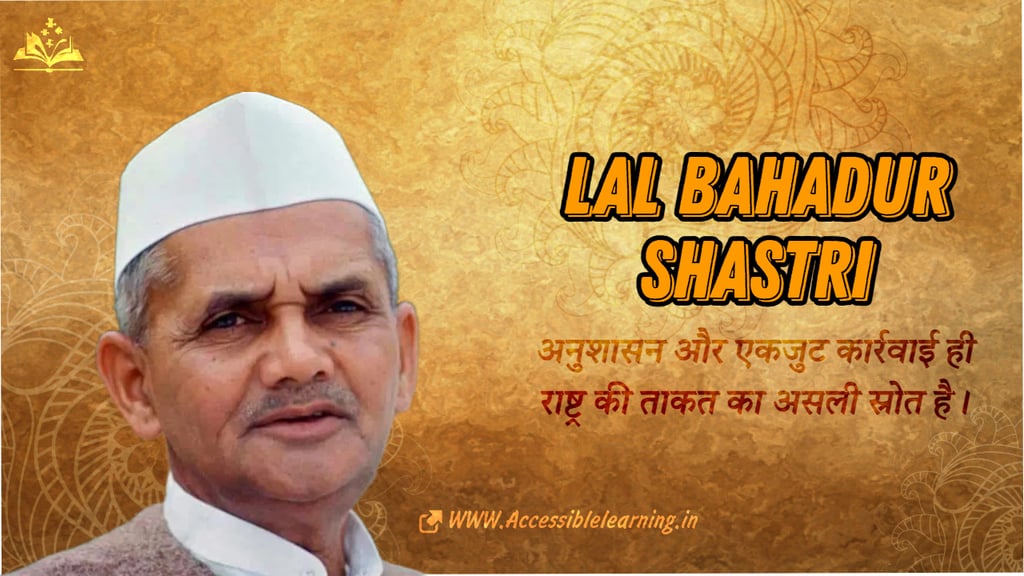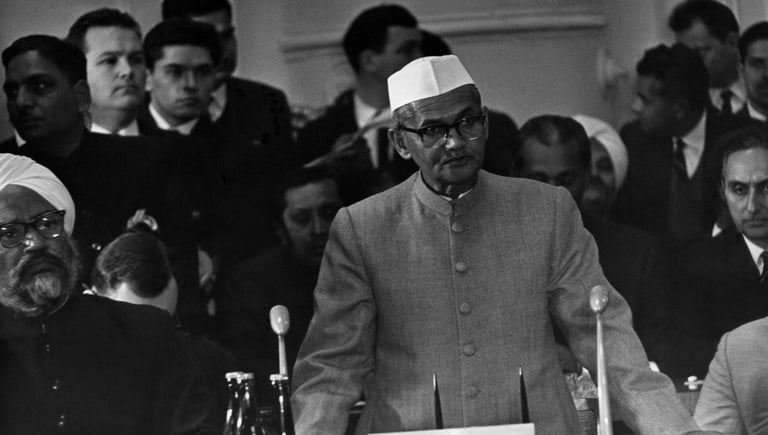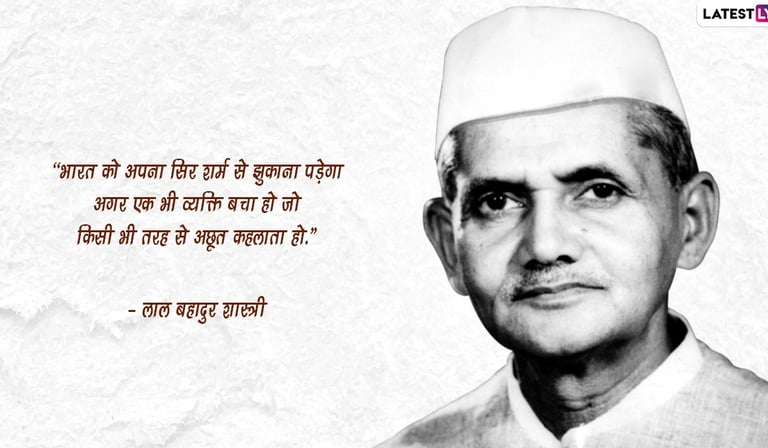
Beyond Jai Jawan, Jai Kisan: The Revolutionary Reforms of Lal Bahadur Shastri's Brief Premiership
Discover the extraordinary life and enduring legacy of India's second Prime Minister, whose unwavering integrity, visionary leadership, and commitment to self-reliance transformed a nation during its most challenging period. From his humble beginnings to his mysterious death in Tashkent, this comprehensive profile reveals the remarkable stories behind the man whose principles continue to inspire India's path forward.
BIOGRAPHY/HISTORYTHE GREAT LEADERINDIAN HISTORYEDUCATION/KNOWLEDGE
Keshav Jha
3/2/20259 min read


Lal Bahadur Shastri/लाल बहादुर शास्त्री, India's second Prime Minister, embodied the rare combination of unwavering integrity and transformative leadership during one of the nation's most challenging periods. Despite his brief 19-month tenure from 1964 to 1966, Shastri's impact on modern India remains profound. His leadership during the 1965 Indo-Pakistan War and his economic policies promoting self-sufficiency established a foundation for India's development that continues to resonate today. This article explores the life, philosophy, and enduring legacy of a leader whose diminutive stature belied his towering influence on the Indian subcontinent.
Early Life & Character Formation
Born on October 2, 1904, in Mughalsarai, United Provinces (now Uttar Pradesh), Lal Bahadur Shastri's formative years were marked by humble beginnings and personal challenges. Losing his father at just one year old, Shastri was raised primarily by his mother, Ramdulari Devi, whose strong moral principles profoundly influenced his development.
A particularly illuminating childhood story reveals Shastri's extraordinary character from an early age. At seven years old, while swimming in the Ganges with friends, he noticed a floating jewelry box. While others were excited about potential treasure, young Shastri insisted on finding its rightful owner, eventually tracking down an elderly woman who had lost it during religious ceremonies. Though his family struggled financially, he refused any reward, establishing a pattern of integrity that would define his life.
Shastri's education reflected both traditional values and nationalist aspirations. After initial schooling in Mughalsarai and Varanasi, he enrolled at Kashi Vidyapeeth, where he came under the mentorship of independence leader Bhagwan Das. Upon graduation, he received the title "Shastri" (scholar), replacing his caste surname—an early indication of his progressive outlook.


Gandhi's Influence and Prison Transformations
Gandhi's influence on Shastri was transformative. After hearing Gandhi speak in 1915, a teenage Shastri became so inspired that he abandoned his studies to join the Non-Cooperation Movement. His mother, though hesitant to lose her son to the independence struggle, gave him her blessing with a poignant statement: "I may lose a son, but the nation will gain a hero."
His prison experiences reveal fascinating aspects of his character. During his nine years of incarceration across multiple sentences, Shastri transformed prison into a personal university. He mastered several languages, including Tamil and Bengali, to better understand India's diverse cultures. Fellow prisoners recalled his habit of meticulously documenting prison conditions to advocate for reforms upon release.
In Firozpur Jail in 1945, Shastri organized clandestine language classes, teaching Hindi to South Indian prisoners and learning Tamil and Malayalam in return. This prison-based cultural exchange later informed his nuanced approach to India's complex linguistic politics as Prime Minister.
The "Little Big Man" in Politics
Standing just 5'2" tall, Shastri's diminutive stature became the subject of numerous anecdotes that highlight his quick wit and self-assurance. When asked by a Western journalist how he felt about being a "little man" leading a large country, Shastri famously replied, "Yes, I am a small man—an ordinary man. But I am representing the ordinary people of India, and as long as I am true to them, my size does not matter."
His physical limitations became symbolic of his strength. During independence marches, despite his small frame, he often volunteered to carry the heaviest flags. When companions expressed concern, he would simply respond, "The burden of freedom is heavy for all of us, but we must each carry what we can."
The Forgotten Family Man
Behind the political figure was a devoted family man whose personal life reveals much about his character. Married to Lalita Devi at the age of 25, their relationship was revolutionary for its time. Despite coming from an era of strict gender roles, Shastri encouraged his wife's independence. When his ministerial duties required long absences, he ensured Lalita received training in household management and financial literacy—unusual priorities for husbands in 1950s India.
His family life was marked by the same simplicity that characterized his public persona. A particularly telling incident occurred when his sons were denied admission to a prestigious school because their father, then a minister, refused to use his influence for preferential treatment. When his children complained, Shastri explained that his position existed to serve the people equally, not to secure advantages for his family.
The family's financial struggles continued even during his premiership. In a remarkable episode, when his son needed ₹5 for school supplies, the Prime Minister had to borrow the sum from his personal secretary, promising to repay it from his next salary—a level of financial restraint almost unimaginable in modern politics.
The Revolutionary Railway Minister
Shastri's tenure as Railway Minister (1952–1956) featured revolutionary reforms that modernized India's massive railway network. His approach to leadership during this period reveals much about his governance philosophy. He personally traveled in third-class compartments (the lowest class) to experience conditions faced by ordinary passengers, often incognito to ensure authentic observations.
After noticing that refreshment vendors targeted first-class compartments while neglecting third-class passengers, he established India's first organized refreshment distribution system specifically designed to serve lower-class carriages first—a small but significant reversal of the colonial-era prioritization of elite travelers.
His most famous act as Railway Minister came after the 1956 Mahbubnagar train accident in Andhra Pradesh that killed 112 passengers. Shastri instantly submitted his resignation, establishing a precedent of ministerial accountability. When colleagues argued the technical fault wasn't his personal responsibility, he delivered a principled response that has become legendary in Indian political discourse: "If I cannot prevent accidents as a Minister, what moral right do I have to continue in office?" Nehru, reluctantly accepting the resignation, reportedly remarked, "I need more men like Shastri if India is to progress."


The White House Meeting and International Impressions
Shastri's 1964 visit to the United States provides fascinating insights into his diplomatic approach. Meeting President Lyndon B. Johnson, Shastri—barely reaching Johnson's shoulder in height—made such an impression that Johnson later told his staff, "I felt like I was in the presence of a giant." During formal negotiations, when Johnson attempted to use America's food aid as leverage, Shastri calmly responded that while India appreciated the assistance, "India would rather starve with dignity than compromise its national interest"—a statement that reportedly earned Johnson's deep respect.
His international appearances were marked by an unassuming authenticity that often caught foreign diplomats off guard. During a state dinner in Moscow, Soviet Premier Alexei Kosygin was surprised when Shastri politely declined alcohol, caviar, and most non-vegetarian dishes. When asked if the arrangements were unsatisfactory, Shastri explained his lifelong vegetarianism and abstinence—personal principles he maintained even during high-stakes international events.
The 1965 War: Leadership Beyond the Battlefield
During the 1965 Indo-Pakistan War, Shastri displayed strategic boldness that surprised both international observers and Pakistani military planners. When Pakistan launched Operation Gibraltar, infiltrating combatants into Kashmir, intelligence reports reached Shastri at 3:00 AM. Rather than waiting until morning, he immediately convened his defense council, making crucial decisions within hours that effectively countered the infiltration.
A remarkable incident during the war revealed his hands-on leadership style. Learning that army supply trucks faced fuel shortages, Shastri personally visited the Delhi Transport Corporation at midnight, requisitioning public buses to transport supplies to the front—demonstrating his willingness to implement practical solutions directly rather than merely issuing orders.
His famous wartime slogan "Jai Jawan, Jai Kisan" (Hail the Soldier, Hail the Farmer) originated in a spontaneous moment. While addressing troops near Amritsar, Shastri deviated from his prepared speech after noticing nearby fields where farmers continued working despite proximity to the conflict. Recognizing their parallel contributions to national security, he improvised the phrase that would become an enduring national motto.
The Mysterious Tashkent Circumstances
The circumstances surrounding Shastri's death in Tashkent remain one of independent India's most persistent mysteries. Beyond the official heart attack explanation, several peculiar details have fueled alternative theories. Shastri's personal physician, Dr. R.N. Chugh, reported that the Prime Minister had no history of heart disease and had passed a comprehensive medical examination just weeks before the Tashkent Conference.
His widow, Lalita Shastri, maintained until her death in 1993 that she observed unusual blue-black patches on her husband's body—inconsistent with typical heart attack symptoms. According to family accounts, Shastri's personal diary and a thermos he habitually used went missing after his death. The Soviet butler who served Shastri his final meal mysteriously disappeared from the official inquiry.
Adding to the intrigue, journalist Gregory Douglas published purported interviews with former CIA operative Robert Crowley, who allegedly claimed that CIA analysis suggested poisoning. However, without official declassification of relevant files by either India or Russia, these claims remain speculative.
In 2009, an RTI (Right to Information) application seeking declassification of Shastri's death records was denied by the Indian government, with officials stating that releasing such information "could harm foreign relations"—an unusual justification regarding events from five decades earlier.
The Forgotten Reforms: Administrator and Innovator
Beyond the headline achievements, Shastri implemented numerous administrative innovations that permanently transformed Indian governance. He established the Central Vigilance Commission in 1964, India's premier anti-corruption body, following the recommendations of the Santhanam Committee. This institution continues to function as a cornerstone of India's anti-corruption framework.
He pioneered the concept of "lateral entry" in Indian bureaucracy, recruiting specialized professionals directly into government positions rather than relying exclusively on career civil servants—a practice recently revived in India's administrative reforms after decades of neglect.
Recognizing linguistic tensions in the newly reorganized states, Shastri developed the "Three-Language Formula" in education policy—a compromise approach that respected regional languages while promoting Hindi and English for national integration. This balanced policy helped defuse potential linguistic conflicts that threatened national unity.


The Spiritual Statesman
Lesser known is Shastri's deep spirituality, which influenced his governance approach. Unlike many politicians who publicly displayed religious observances, Shastri maintained a private spiritual practice centered on daily meditation and study of the Bhagavad Gita. According to his personal secretary, Shastri began each day with 30 minutes of silent meditation, regardless of his schedule's demands.
During the 1965 war, when advisors urged immediate retaliation after Pakistani incursions, Shastri reportedly requested a few minutes alone, during which he meditated before making his decision. When later questioned about this pause during a national emergency, he explained, "The greatest decisions affecting millions should never be made in haste or anger."
His interpretation of karma yoga (the spiritual path of selfless action) as a governance principle led him to encourage government officials to view their roles as service rather than authority—a significant departure from the colonial administrative mindset that had persisted after independence.
Cultural Legacy and Popular Memory
Shastri's cultural impact extends beyond formal politics into Indian arts and popular consciousness. Numerous folk songs in northern India still celebrate his leadership during the 1965 war. The famous Hindi poet Ramdhari Singh Dinkar described him as "Ram-like in his simplicity, Krishna-like in his diplomacy"—a poetic tribute that captured his complex leadership style.
Shastri's image appeared on Indian postal stamps in 1976 and 2004, and the Indian government established the Lal Bahadur Shastri National Academy of Administration in Mussoorie—India's premier civil service training institution—to commemorate his administrative ideals.
In popular culture, Shastri's life inspired Anil Kapoor's character in the 2018 film "Ek Ladki Ko Dekha Toh Aisa Laga" and was directly portrayed in the 2021 film "The Tashkent Files," which dramatized theories surrounding his death. These cultural representations keep his legacy alive in contemporary Indian consciousness.
Contemporary Relevance: The Shastrian Approach
The principles Shastri championed—ethical leadership, agricultural self-sufficiency, and administrative accountability—continue to offer solutions to contemporary challenges. Recent Indian economic initiatives like "Make in India" and "Atma Nirbhar Bharat" (Self-Reliant India) explicitly reference Shastri's economic philosophy as inspiration.
His environmental foresight deserves greater recognition. Decades before environmental concerns became mainstream, Shastri advocated sustainable agriculture and water conservation. He established India's first specialized water resources ministry in 1964, recognizing that water security would become critical to India's future—an insight now acknowledged as prescient given India's current water management challenges.
Perhaps most relevant today is Shastri's ability to unite a diverse nation without suppressing its pluralism. His inclusive approach to governance, respecting regional and religious differences while promoting national cohesion, offers a model for managing the tensions inherent in diverse democracies worldwide.
Lal Bahadur Shastri's life exemplifies how leadership rooted in moral authority rather than mere political power can achieve transformative outcomes. The rich tapestry of personal anecdotes, administrative innovations, and historical circumstances surrounding his leadership reveals a figure whose significance extends far beyond his brief tenure.
In an era of political polarization globally, Shastri's capacity to build consensus through personal example rather than rhetoric offers valuable lessons. His greatest contribution may be the demonstration that simplicity, integrity, and dedication to public service need not be mere ideals but can serve as practical foundations for effective governance.
As contemporary India navigates increasingly complex challenges, the Shastrian approach—combining ethical leadership with pragmatic solutions—provides a uniquely Indian model of governance that honors the nation's spiritual and cultural heritage while embracing necessary modernization. His legacy reminds us that the measure of leadership lies not in the duration of power but in the depth of positive change it enables—a standard by which few modern leaders in India or elsewhere could claim to match the humble giant, Lal Bahadur Shastri.
Subscribe To Our Newsletter
All © Copyright reserved by Accessible-Learning Hub
| Terms & Conditions
Knowledge is power. Learn with Us. 📚


